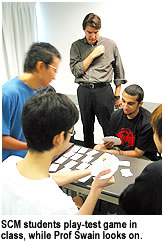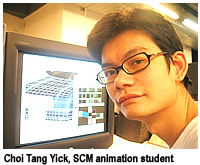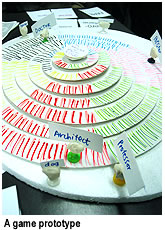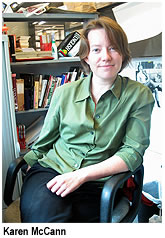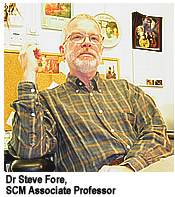Demystifying the craft of game design
"The workshop course was intensive, fun and inspiring. As well as a lot of fundamental concepts of game design and structural planning, the course also invited us to look at game design from alternative perspectives—an approach originating from an emotional point of view, namely, the intuitive method," commented Choi Tang Yik, an SCM animation student. "As an animator, I believe study of the structure of games is inevitable since the future development of animation will rely heavily on game design," he asserted.
Designing from scratch
The course was designed to provide the knowledge foundations for becoming a professional game designer. “The course employed a holistic approach. It did not stress our technical competence with different software that is likely to become obsolete very quickly. Rather," Tang Yik said, “we were engaged with the solid mechanics of the designing process, which tends to be less software-specific and hence more flexible." “Over the years we’ve learned how to guide a beginner to grasping concepts like how you design playable systems, or a different kind of game play,” Professor Swain added. “Often, people just rush into designing a game and that’s one of the reasons why you see a lot of games that are so very similar out there on the market.”
Constructing a physical prototype is an important part of the creative process, according to
According to Ms Karen McCann, SCM Lecturer, the hands-on aspect of the game design course gave the students an approach that allowed them to cooperate with each other and thoroughly test their ideas. "It has really stimulated the students' imaginations to work closely together in small groups and to construct physical models rather than work in isolation facing a computer screen. You can tell how much they enjoyed the experience by the buzz in the air as they discussed the concepts and methods, and the smiles all round as they played their games together," she said.
“These SCM students are very good at working in teams, which is important,” Swain observed. “Professionally, we consider it to be a skill you have to practise; for them it just seems natural.” By the end of the course, the students had at least two full, original, well play-tested games that they could take to the next step and build software versions. “What we hope they do is take the concept of intuitive design that they have been creating on paper and see how it can be applied on a computer, with very simple programme,”
"This workshop course has been a very successful one," noted Dr Steve Fore, SCM Associate Professor. "The students were very happy with it and the SCM professors have been equally impressed." Thanks to the trilateral agreement among CityU, the USC and the Beijing Film Academy (BFA), the SCM will receive two Professors from the BFA for another animation course in the coming year. "The SCM is fortunate to have benefitted from the expertise of USC Professors Fullerton and Swain," Ms McCann added. "I am excited at the prospect of further opportunities to collaborate with our overseas partners in multiumedia education."
The USC and the BFA, renowned for their excellent teachers and students, decided to unite with the SCM in the Agreement order to benefit from the School's ground-breaking interdisciplinary teaching and learning model, in line with the direction of new media and interactive art. "Since the Agreement is a permanent arrangement that is infinitely renewable, in terms of practicality, it should definitely boost the development of the industry and the media profession," Dr Fore said.
“It’s tremendously valuable to get a different perspective on things and see different students and different faculties," Swain said, "and there are lots of awesome ideas that we got here to take back to our class in the
In addition to their work as educators, Professors Fullerton and Swain are working game designers with over a decade of professional experience. Their recent freelance clients include Disney Imagineering, and F/X Network. They founded the game developer, Spiderdance, Inc. Spiderdance’s mass audience interactive television games included NBC’s Weakest Link and the History Channel’s History IQ among others. Before starting Spiderdance, they were founding members of the
Kirque Leung contributed to this article.


